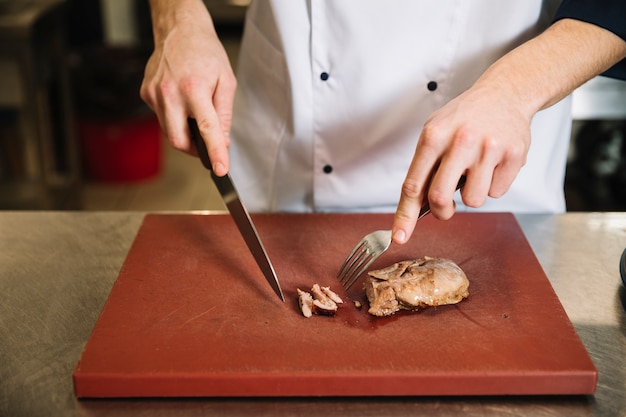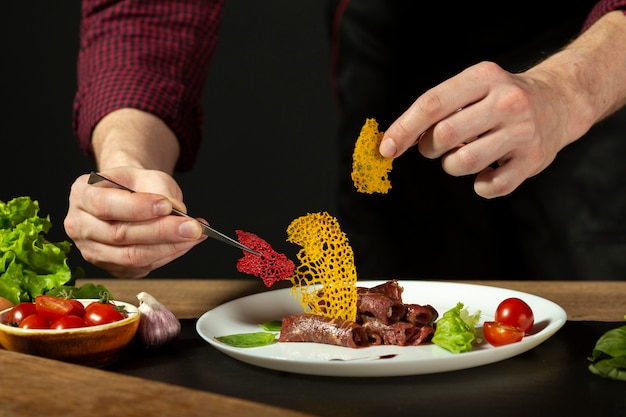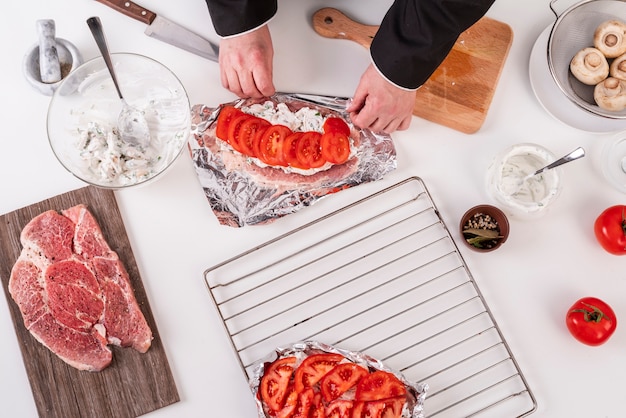Let's talk steak, shall we? I've always been a bit of a steak enthusiast. There's something incredibly satisfying about a perfectly cooked piece of meat – that beautiful sear, the juicy tenderness, the rich aroma – it's pure culinary bliss. Over the years, I've had my fair share of steak adventures, both successes and, well, let's just say some less-than-perfect experiences. But through it all, I've learned a thing or two, and I'm here to share those secrets with you. This isn't just a guide; it's an invitation to join me on a journey into the world of steak, from choosing the perfect cut to mastering the art of grilling and pan-frying. So, grab your apron, sharpen those knives, and get ready to level up your steak game.
(Part 1) choosing the right cut: The Foundation of Your Steak Journey

Before we even think about cooking, we need to pick the right cut. It's like choosing the right canvas for a painting – the foundation matters. Now, I know what you're thinking, there are a gazillion different cuts of beef out there, right? Don't worry, we'll break it down.
The Big Three: Your Classic Steak Choices
Rib-Eye: My personal favourite, the Rib-Eye is known for its rich marbling, which translates to a wonderfully juicy and flavourful steak. It's also got a good amount of fat, which means it's perfect for grilling or pan-frying. Imagine a steak so tender, it practically melts in your mouth – that's the Rib-Eye for you.
new york strip: A bit leaner than the Rib-Eye, the New York Strip has a more prominent grain, giving it a slightly firmer texture. It's a great choice for those who prefer a bit more chew with their steak. Think of it as the athletic, toned sibling of the Rib-Eye, offering a bit more muscle.
Sirloin: This versatile cut boasts a nice balance of flavour and tenderness, making it a true all-rounder. It's fantastic for grilling and pan-frying, and it won't break the bank either. If you're looking for a dependable, well-rounded steak experience, the Sirloin is your go-to.
Beyond the Basics: The More Adventurous steak cuts
If you're feeling a bit more adventurous, there's a whole world of steak cuts to explore:
filet mignon: This is the most tender cut of steak, renowned for its buttery texture and delicate flavour. Think of it as the epitome of steak elegance, ideal for those who prefer a more refined steak experience.
Tenderloin: A slightly less expensive cousin of the Filet Mignon, the Tenderloin shares the same tender texture and is often cooked as a whole roast. It's a great option for a special occasion or when you want to impress your guests.
T-Bone: This cut, combining a strip steak and a filet mignon, offers a captivating contrast of textures and flavours. It's the classic choice for steak lovers who want a little bit of everything.
A Word of Wisdom: The Importance of Thickness
No matter which cut you choose, make sure it's at least 1 inch thick. This will help ensure it cooks evenly and doesn't dry out. Think of it as a culinary rule of thumb for steak perfection.
(Part 2) Getting the Right Temperature: The Science of steak doneness

Now that you've got your cut, it's time to talk temperature. This is where we delve into a bit of steak science, but don't worry, I'll keep it simple.
Understanding the Doneness: From Rare to Well Done
Rare: 125°F (52°C) – For the brave souls who like their steak with a cool, red centre, rare is the way to go. It's a bit of a commitment, but if you appreciate that raw, intense flavour, then rare is your jam.
Medium-Rare: 130°F (54°C) – My personal sweet spot, medium-rare is where you get that perfect balance of pinkness and warmth. The centre is still pink, but it's a bit more cooked through than rare. It's the classic steak experience for many.
Medium: 140°F (60°C) – The steak is cooked through with a slightly brown centre. This is the most popular doneness for steak, offering a comforting familiarity and a satisfyingly cooked experience.
Medium-Well: 150°F (65°C) – The steak is cooked through with a brown centre, less pink than medium and a bit more firm. It's a good option for those who like a bit more cooked steak without venturing into well-done territory.
Well Done: 160°F (71°C) – This is the most cooked option, with a dark brown centre. It's for those who prefer their steak fully cooked, although some people find it a bit dry.
Tools of the Trade: Measuring Your Steak's Success
To get the perfect temperature, you'll need a good meat thermometer. There are digital ones, which are fairly affordable and accurate, and there are also instant-read ones, which are great for a quick check. Think of them as your culinary compass, guiding you to steak perfection.
(Part 3) The Art of Seasoning: Enhancing the Steak's Natural Flavor

Before we get to the actual cooking, let's talk seasoning. It's a crucial step that can make or break your steak.
Simple is Best: The Power of Salt and Pepper
In my opinion, less is more when it comes to steak seasoning. You want to enhance the natural flavour of the meat, not mask it. My go-to seasoning is a simple blend of salt and pepper. It's like adding the perfect brushstroke to a painting, enhancing the natural beauty of the subject.
Adding a Touch of Flair: spices and herbs to Elevate Your Steak
If you're feeling a bit more adventurous, you can add a pinch of garlic powder, onion powder, or paprika. Just remember, a little goes a long way. Think of it as a subtle whisper of flavour, adding a touch of complexity to your steak.
Don't Salt Too Soon: A Culinary Secret
Here's a little secret I've learned: don't salt your steak too early. Salt draws out moisture, so you want to season it right before you cook it. This ensures that the salt has time to penetrate the meat and enhance its flavour without making it dry.
(Part 4) Mastering the Grill: The Outdoor Steak Experience
Alright, time for the main event – grilling. This is where the real magic happens.
Hot and Fast: The Key to a Perfect Grill
The key to grilling a perfect steak is to cook it over high heat. This creates a delicious sear and locks in the juices. Imagine those beautiful grill marks, the aroma of smoky char, and the juicy, tender steak – that's what grilling is all about.
Preheating is Key: Setting the Stage for Success
Make sure your grill is nice and hot before you put the steak on. Aim for a temperature of around 500°F (260°C). A hot grill is essential for that perfect sear. It's like prepping your canvas for a masterpiece – a hot grill ensures that your steak is ready to shine.
Grilling Techniques: Direct Heat vs. Indirect Heat
Direct Heat: This is the most common method, where you cook the steak directly over the flame. It's perfect for a quick sear and even cooking. This is the classic grilling experience, where the steak is exposed to the full intensity of the flames.
Indirect Heat: This method involves cooking the steak over a cooler part of the grill. It's great for cooking larger cuts of meat or for those who prefer a more even cooking. This technique is ideal for larger cuts or when you want a more gentle cooking process.
Time is of the Essence: Timing Your Steak's Journey
The amount of time you need to grill your steak will depend on the thickness and the level of doneness you're aiming for. A good rule of thumb is to cook a 1-inch thick steak for 4-5 minutes per side for medium-rare.
(Part 5) Pan-Frying Perfection: steak mastery in Your Kitchen
Not everyone has a grill, and that's perfectly okay. Pan-frying is a fantastic alternative that can yield equally amazing results.
The Right Pan: The Foundation for Your Steak Success
You want a heavy-bottomed pan that can distribute heat evenly. Cast iron is a classic choice, but any good quality pan will do. Think of your pan as a culinary stage for your steak to shine.
Oil is Your Friend: Choosing the Right Lubricant
Use a high-heat oil, like grapeseed or avocado oil. These oils have a high smoke point, so they won't burn easily. They'll help you achieve that beautiful sear and prevent your steak from sticking to the pan.
Searing is Crucial: The Art of a Perfect Crust
Just like grilling, pan-frying is all about getting a good sear. Heat the pan over high heat, add the oil, and then sear the steak for 2-3 minutes per side. That beautiful brown crust is not just visually appealing; it's a testament to the flavour and texture you're about to experience.
Time to Rest: Letting the Steak Relax and Redistribute its Juices
Once the steak is cooked to your liking, remove it from the pan and let it rest for 5-10 minutes before slicing and serving. This allows the juices to redistribute, resulting in a more tender and flavorful steak. Think of it as giving your steak a moment to breathe, allowing its flavours to bloom.
(Part 6) The Finishing Touches: Adding a Touch of Finesse to Your Steak
You've cooked your steak to perfection, but there's still room for some final flourishes.
A Touch of Butter: A Simple Sauce with Big Flavour
Adding a knob of butter to the pan after you remove the steak can create a beautiful sauce. As the butter melts, it will pick up all the delicious steak juices and flavourings, creating a symphony of flavour in your mouth.
Herbs and Spices: A Whisper of Flavor to Elevate Your Steak
A sprinkle of fresh herbs or a pinch of your favourite spices can add a touch of flavour to your steak. Rosemary, thyme, or parsley are always good choices. They add a touch of aromatic complexity to your steak, like a subtle melody in a culinary symphony.
A Side of Perfection: Pairing Your Steak with the Right Accompaniment
No steak is complete without a delicious side dish. Some classic pairings include roasted vegetables, mashed potatoes, or a simple salad. Think of them as the supporting cast, adding texture and flavour to your steak performance.
(Part 7) FAQ: Your Steak Questions Answered
1. How do I know if my steak is done?
You can use a meat thermometer to check the internal temperature of your steak. But if you're feeling adventurous, you can also use the touch test. Simply press on the centre of the steak with your finger. If it feels soft and springs back, it's rare. If it feels firm and springy, it's medium-rare. If it feels firm and doesn't spring back, it's medium.
2. What if I overcook my steak?
Don't worry, it happens to the best of us. If you've overcooked your steak, you can try to salvage it by slicing it thin and adding it to a salad or stir-fry.
3. How do I make a steak sauce?
There are countless steak sauces out there, but a simple one can be made by combining butter, Worcestershire sauce, and your favourite herbs and spices. Let your creativity flow, and experiment with different flavours.
4. Can I cook a steak in the oven?
Yes, you can. It's a great option for larger cuts of meat or if you prefer a more even cooking. It's like creating a steak in a warm embrace.
5. What are some good tips for storing leftover steak?
Store leftover steak in the refrigerator for up to 3 days. You can also freeze it for up to 3 months. Make sure to wrap it tightly in plastic wrap or aluminum foil to prevent freezer burn.
(Part 8) The Journey Continues: Your Steak Adventure Awaits
There you have it, folks, your ultimate guide to cooking steak at home like a pro. Remember, practice makes perfect. So get out there, experiment with different cuts, seasonings, and cooking methods. And most importantly, have fun! The world of steak is vast and full of delicious possibilities. Get ready to embark on your own steak journey, where every bite is an adventure.
Everyone is watching

Corn on the Cob: The Ultimate Guide to Perfectly Cooked Ears
Healthy MealsAh, corn on the cob. Just the name evokes images of sunny days, barbecues, and that sweet, juicy flavour that ...

Perfect Pork Roast Oven Cooking Time: A Guide to Delicious Results
Healthy MealsThere's something truly satisfying about a perfectly roasted pork. The aroma alone is enough to make your mout...

Ham Cooking Time: How Long to Bake, Smoke, or Boil a Delicious Ham
Healthy MealsAh, ham. It's a classic, isn't it? A real crowd-pleaser, especially around holidays. And when done right, it'...

Scallops: The Ultimate Guide to Perfect Cooking
Healthy MealsAh, scallops. Those delicate, sweet, and utterly delicious morsels of the sea. They hold a special place in my...

Spaghetti Squash: The Ultimate Guide to Cooking and Serving
Healthy MealsRemember that time you saw spaghetti squash at the supermarket, looking all bumpy and strange, and thought, "W...
